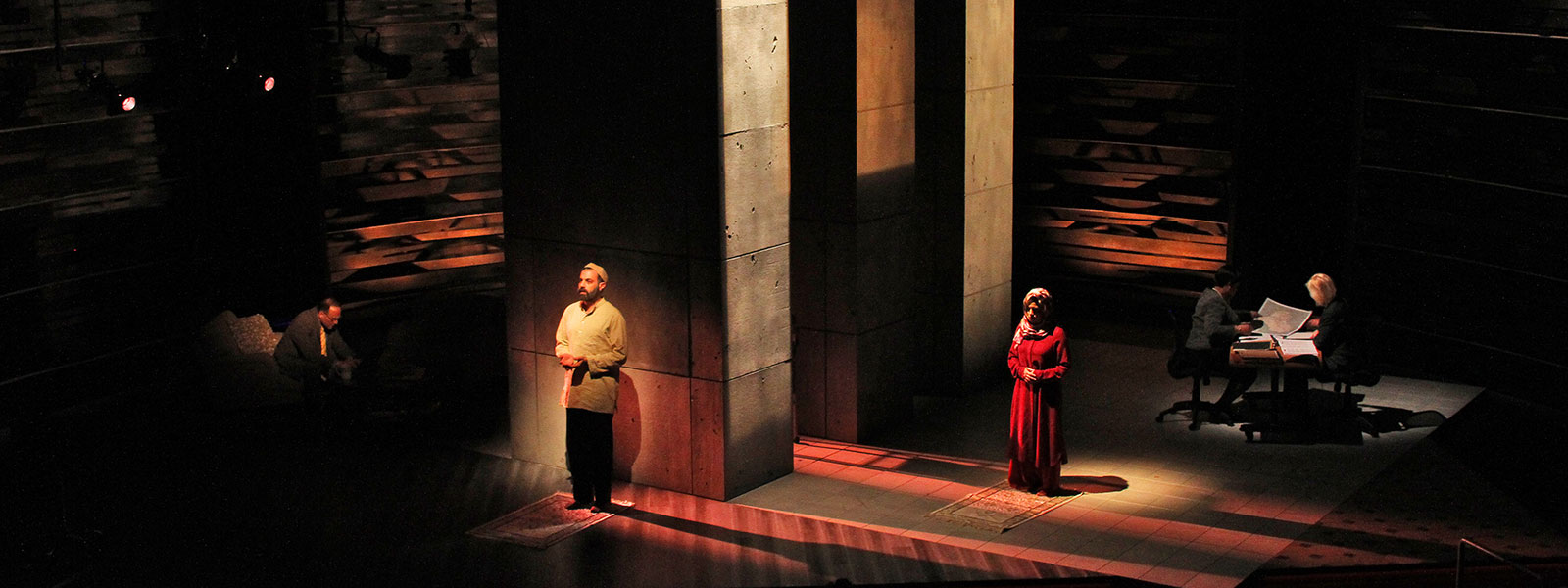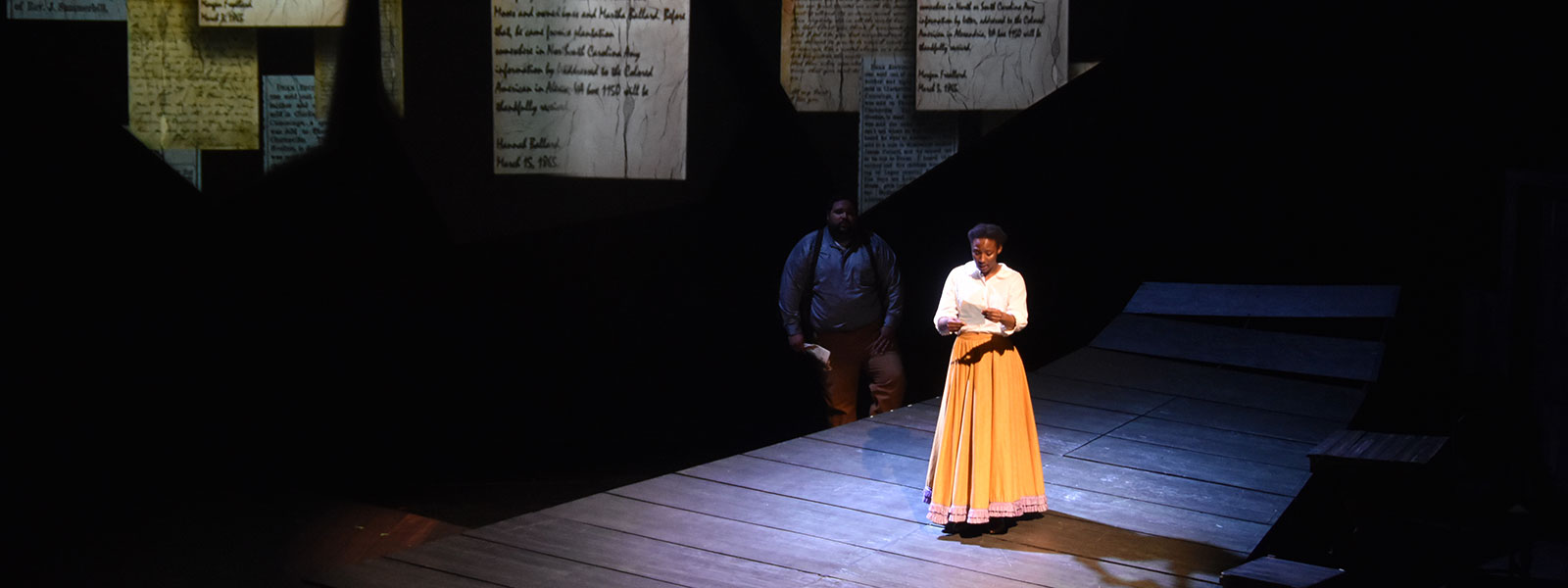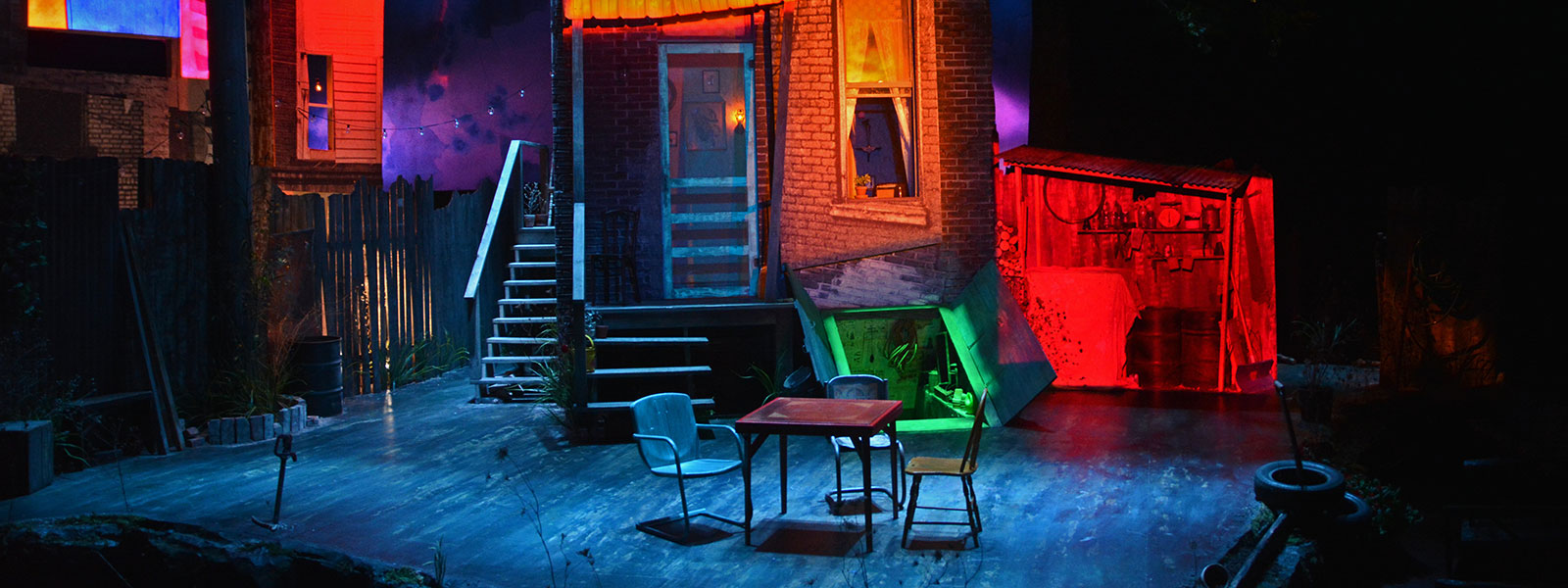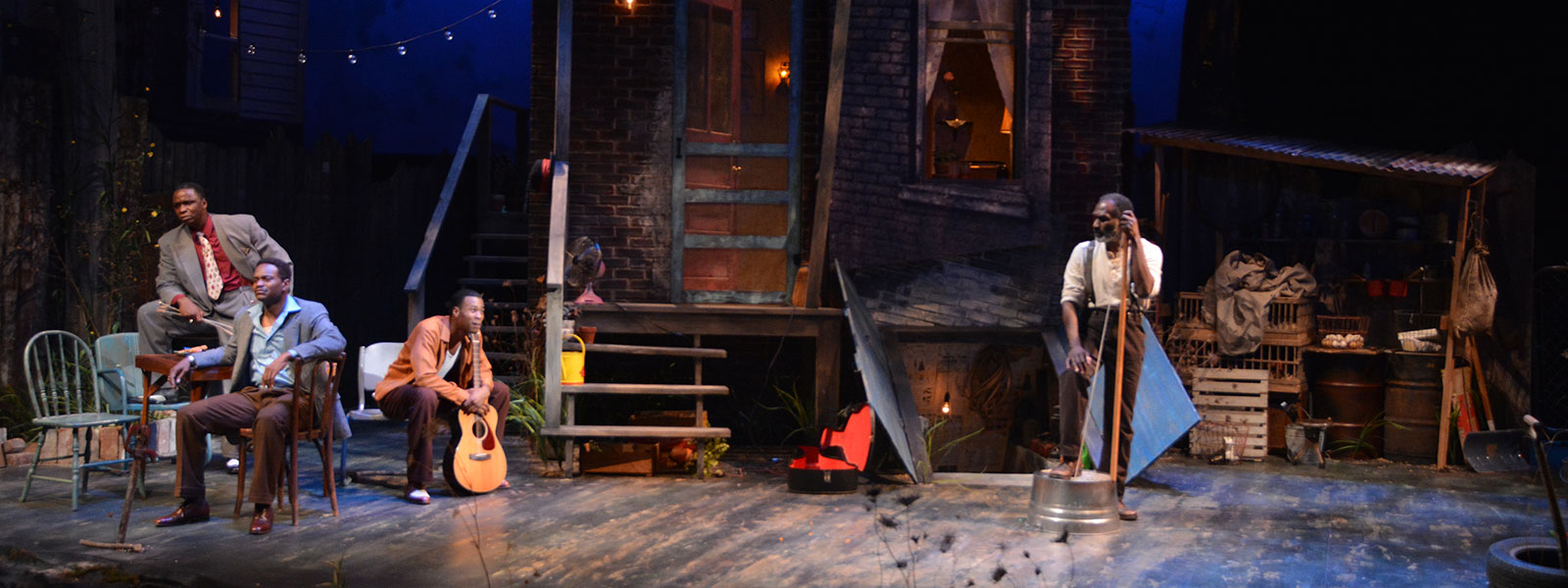Kathy A. Perkins
The views and opinions expressed by speakers and presenters in connection with Art Restart are their own, and not an endorsement by the Thomas S. Kenan Institute for the Arts and the UNC School of the Arts. This interview has been edited for length and clarity.
Over the course of a remarkable 45-year career, lighting designer Kathy A. Perkins has worked in theaters all over the United States and as far away as South Africa and Cuba. She has also cultivated a distinguished academic career as a theater historian, editing or co-editing several collections of plays and textbooks, including most recently “The Routledge Companion to African American Theater and Performance.” She chaired the MFA lighting department at University of Illinois at Urbana-Champaign for 20 years, and in 2012 she joined the faculty at UNC Chapel Hill, where she is currently Professor Emerita of Dramatic Art.
In this conversation with Pier Carlo Talenti and Rob Kramer, Kathy considers the upheaval of the last year through the lens of a theater veteran, a trailblazer in a field where exceedingly few women, much less Black women, have been able to make a career.
Choose a question below to begin exploring the interview:
- Can you tell us about a project in the upcoming year that you’re particularly excited to leap into?
- As you know, the chaos of last year created a lot of turbulence for artists. Given your depth of knowledge about the history of Black artists working in the theater, can you give us your perspective of what opportunities might be presented for women and for BIPOC designers coming out of the COVID experience?
- You started off getting your BFA at Howard university in the early ’70s. How does the theater scene today for BIPOC artists and designers look different from the early ’70s?
- You’ve worked in theaters all over the country. What might you know that they don’t realize about the way they operate and about their fundamental beliefs?
- What do you see as most broken in the system, in terms of attracting, hiring and retaining black artists?
- Knowing what you know now, what would you tell your 24-year-old self back in the ’70s?
- What did it take for you to finally feel like you’d reached a place where you felt like you’d broken through and had established yourself as a credible, sought-after artist?
- Are you seeing changes in diversity in the technical unions that you work with?
- In your conversation with the designer tomorrow, what do you think is the most important piece of advice you’re likely to give her?
Pier Carlo Talenti: Can you tell us about a project in the upcoming year that you’re particularly excited to leap into?
Kathy A. Perkins: I have a book that hopefully by the end of the week I will be sending off to a publisher. I’m working on a new collection of plays. It’s called “Telling Our Stories of Home: International Performance Pieces By and About Women.” That’s something I’m very excited about.
I have a possible Broadway show coming in the fall. I don’t want to mention a name, because [laughing] until I have it signed in ink, I don’t want to announce it. But those are two things I’m looking forward to.
Pier Carlo: Wow, congratulations.
Kathy: Yes, thank you.
Rob Kramer: As you know, the chaos of last year created a lot of turbulence for artists. Given your depth of knowledge about the history of Black artists working in the theater, can you give us your perspective of what opportunities might be presented for women and for BIPOC designers coming out of the COVID experience?
Kathy: Well, we’re hoping that there will be more opportunities for people of color, particularly Black people, to direct, design, have plays produced. I’m beginning to see that with a lot of the upcoming seasons. Some of the regional theaters are becoming a little bit more inclusive. I’m hoping that this is just not a trend for a year or two and then things go back to the way they were, which tends to be the case throughout history.
I’ve been in the business for 45 years and I don’t get excited at moments like this, because I know it’ll just be a momentary thing, but I’m hoping I’m wrong. Because I think technology, social media, is shaming people. And I think, I don’t know, things may get better. Like I said, I’ve been in this for 45 years, and every time something like this happened … . We had the death of Dr. King. Things were going to change; I was 13 at the time. Every time there’s a major event, it’s like, “Oh, we need to do better!” And then things will happen for a year, and then we go back to the way it was.
I would like to think that things are going to change for the long term this time around. Like I said, it could be because of social media and people are being shamed and there are more voices out here. And the world is watching us.
No, I would like to think that things are going to change for the long term this time around. Like I said, it could be because of social media and people are being shamed and there are more voices out here. And the world is watching us.
Rob: You started off getting your BFA at Howard university in the early ’70s. How does the theater scene today for BIPOC artists and designers look different from the early ’70s?
Kathy: I think there are more young people getting degrees, going to school, which is good. Whether they’re working more, that’s another story. I know particularly in the case of Black women in lighting and even women across the board in lighting, it has not been very easy.
There’s a young woman, Porsche McGovern, who’s a lighting designer. I think she’s been doing this for maybe six or seven years, where she’s been doing these statistics of women working off-Broadway, on Broadway, in regional theaters. Maybe two years ago, I think the number of women working professionally in New York city was less than 23%, although we are about 50% of the MFAs coming out of universities. The numbers are low; I I think they’ve gotten a little better. But women don’t work as much as white men. And we just don’t see them on Broadway in large numbers. Or the regional theaters.
Pier Carlo: Right. You were saying that you’re afraid that this might be just a one-off for one or two years, kind of a token gesture that theaters will make to include people of color and then go back to normal. A lot of regional theaters, as you know, have come up with more concrete plans in response to social media movements like #WeSeeYou White American Theater, but where do you think the greatest resistance will come from? You’ve worked in theaters all over the country. What might you know that they don’t realize about the way they operate and about their fundamental beliefs?
Kathy: They know how they operate! [She laughs.] I mean, some will pretend that they don’t know.
What I’m always hearing is, 'We can’t find Black people.' And that’s a myth. Ten years ago I started a Facebook page called 'Black Designers.' There are a lot of designers on there; they’re always looking for work.
What I’m always hearing is, “We can’t find Black people.” And that’s a myth. Ten years ago I started a Facebook page called “Black Designers.” There are a lot of designers on there; they’re always looking for work. Another colleague of mine, they started another website called “Create Ensemble,” which is actually a better site because anybody can go to it. My site is a private site just for Black designers for discussion and networking and everything like that. I know her site is much better. I’m telling people to migrate to that site because I really want to get off Facebook altogether. And this would be a site where people can easily find folks, instead of people contacting me and saying, “Can you give us a list of people?”
They need to just basically hire us. I think there’s this sense that we aren’t capable of designing shows. I mean, like I said, I’ve been in this business for 45 years. I have the same MFA degree that my white colleagues have, and I’ve been passed over for shows by a young white guy who may have had maybe a third of the amount of experience that I’ve had.
So there’s this whole thing about, “A Black person can’t do this,” or, “Women don’t understand the new technology.” I guess you have to get these folks out of that kind of mindset.
And there’s a sense that we can only design Black shows. February is my busiest month. I always tell people, “I can design outside of February.” I don’t have to do the Black show, although I enjoy doing a Black show. That’s my area of expertise, Black theater. But I can do Tennessee Williams or Paula Vogel or whatever.
Rob: What do you see as most broken in the system, in terms of attracting, hiring and retaining black artists?
Kathy: I don’t know, without saying it’s just a racist business. We’ve always had difficulty. When you look at the history of Blacks in design, it’s always been difficult.
I was sitting here; I was just sending a picture. There’s a guy named George Corrin. He’s deceased. He was the first Black to go to Carnegie Mellon. Don’t quote me with the years. I don’t know if it was ’39. I think he finished in ’39. He ended up getting his MFA from Yale. He was the first Black person to go to Carnegie Mellon; it was called Carnegie Tech at the time. I have all these letters going back and forth. They were making all the excuses why he shouldn’t be there, because in the early years it was very difficult for Black men to go into theater programs at PWIs, predominantly white institutions. One, there was this fear that they would be intimate with white women. So they didn’t get into these schools. It wasn’t really until the ’60s, ’70s that you saw Black men going into acting. A lot of them had actor training either at private places, or most of them went to HBCUs.
So yeah, that’s part of the problem; there’s a sense that we don’t belong here. I’ve been listening to different people in my group talk about it. There’s one guy — he’s union, a little younger than me — who just said, “I’m just leaving the business. They really don’t want us here, so I’m just going to go out and do my own thing.”
I think in this period — in a way it’s sad — I think in this period of this pandemic and the whole George Floyd thing, I’m seeing particularly Black designers, they’re thinking about just leaving the business altogether. Right now there’s a lot opening up in TV and film. There are a lot of Black playwrights, Black directors who are getting positions, and these playwrights and directors are bringing in young Black artists. So a lot of them are migrating to TV and film. They say, “I can make a living. I’m working with somebody that respects me, a team of people that respects me.” I’m seeing a lot of this happening.
There’s a friend of mine, who’s an amazing set designer … because there are not a lot of Black women set designers, and the few that I know, it’s like, “No, I’m working as art director on this TV show and this game show. I don’t think I’ll go back to theater.”
Rob: Knowing what you know now, what would you tell your 24-year-old self back in the ’70s?
Kathy: Oh, no, I knew what I was getting into!
I went to an HBCU. That’s very different from a Black person going to a white institution. I was at Howard University in the ’70s. We had a touring house on campus — it’s still there — and my advisor was the guy who ran our touring house. His name was Ralph Dines, and he was the biggest mentor in my life.
Mr. Dines taught me the ins and outs of the business. He was in charge of … is it Local 824? Whatever the IA Local is in D.C. At the time, IA [short for IATSE, the International Alliance of Theatrical Stage Employees] used to be segregated. Anything that had an A behind it, like local 1A, were Black people; Local 2A were Black people. Mr. Dines, and there was another guy named Berkley Williams, they both worked at our touring house. I think one had been secretary of the union and one had been president, but they really knew the ins and outs of the business.
They were so smart. What they did is, the Black Locals began to merge with IA in the ’50s or ’60s or something like that. I forget when it became a law that they could no longer be segregated. And Mr. Dines was so smart. He waited until the ’70s or early ’80s to merge with the white union. Years later when I interviewed him about all of this — because that’s when I was doing my research — I said, “Why did you all wait so late to merge with the white Local or the main Local?” And he said he did this because he was trying to get as many Blacks into Local IA as possible so that when they merged, they would be the dominant group in D.C in the Locals. Because, you see, he noticed that when a lot of these Black Locals merged with the main Local, you began to see fewer and fewer Blacks getting in, because the officers were still predominantly white. Basically they were white. Things have changed somewhat now, but I just thought that was so smart of him.
He said, 'You’re going to be humiliated; you’re going to need to expect this. ... You’re going to be overlooked for people who are going to be mediocre.' So I was prepared. When I got out there, nothing was new.
When I told him that I was seriously thinking about pursuing lighting as a career, he said, “Come to my office. Set aside an hour and a half. We need to talk.” And he sat and talked to me. He just said, “You’re a Black woman; you’re here in D.C.; this is family; 90% of the people you work with are Black. It’s going to be a whole different world when you get out of here, when you go to grad school, when you start working.” He said, “You’re going to be humiliated; you’re going to need to expect this. And you cannot take this stuff … well, yeah, you should take it personally, but this is the way the business works. You’re going to be overlooked for people who are going to be mediocre.” So I was prepared. When I got out there, nothing was new.
Rob: What did it take for you to finally feel like you’d reached a place where you felt like you’d broken through and had established yourself as a credible, sought-after artist?
Kathy: That’s an interesting question. In a way I’ve been sought after, but it was mainly within my Black community. For me, like I said, coming from an HBCU, that was important for me, because when I left Howard or Michigan, my goal was not Broadway. My goal was to work at a place like the Negro Ensemble Company, which I did. I was there during the time of Phylicia Rashad and Denzel Washington, well, between the Negro Ensemble Company and the New Federal Theater. For me that was success.
If I happened to get to Broadway, that was fine, although I did assist another mentor, Shirley Prendergrast. She was — and is still the only one — the first Black woman to design on Broadway. She did several shows. I was told to look her up, and when I got to New York, I did. She was a big mentor of mine.
I assisted her on a Broadway show. This was like 1980, I think. She trusted me. She says, “Why don’t you go in two hours before me and start focusing? You can start doing all the back-light and the down-light.” Because that was easy to do. And so I get to the theater at 8 o’clock; my call was at 8.
The other thing is I have a very white name, I’ve been told. Kathy Perkins is a white name. When people look at my resume, the only thing that gives away that I’m a Black woman is Howard University. A lot of people don’t know anything about HBCUs. So if you don’t know Howard University, you will assume I’m white. I went to University of Michigan, I have an MFA, I worked in Europe. The fact that I’ve designed Black shows doesn’t mean anything because most Black shows are designed by white designers. So looking at my resume, it’s assumed that I’m a white woman.
So anyways I go into the theater. It’s 8 o’clock. Back then you had what was called an A-frame. It’s a ladder, shaped like an A. You had to have four people, a guy on each end of the ladder, and then the fifth person goes up. You had to have a five-person crew; that’s the union standard. I walk in and I introduce myself, and the five white guys on the ladder, they sort of look at me, like, “Really?” And then one guy proceeds to say, “I ain’t working with this,” and walks away. He didn’t even say, “I’m not working with her.” He says, “I ain’t working with this,” and he leaves. He walked away. I looked at the supervisor, the master electrician, and I say, “Well, what are you going to do about that?” It’s like, we’re on a clock, time is money, and this is Broadway. And this is my first time working in a Broadway house. And he says, “Oh, we’re the brotherhood.” He started telling me all this crap about “We’re IA brotherhood, and I can’t really do anything to him.”
And I said, “Well, I’ve got to focus this show. What are you going to do?” “Well, I’m going to call so-and-so who lives in Jersey somewhere.” And I’m looking at my watch. I said, “That’s like an hour away in rush hour! He’s got to come across the George Washington Bridge. He’s not going to get here before 9.” He said, “Well, there’s nothing I can do about it. So everybody take a coffee break.”
And my reaction was, I wanted to just cry. I was listening to Mr. Dines’ voice: “Don’t ever let anybody make you cry.” He said that’s the worst thing. He said, “Don’t ever let anybody make you cry. You don’t cry onstage. You go to the bathroom and then cry. Don’t ever let anybody see you cry.” And so I always taught my female students, “Don’t let anybody make you cry.” But I wanted to cry not so much because I felt humiliated — like I said, I was prepared for all of this — but I wanted to cry because I felt that I had disappointed my mentor. Shirley Prendergast had designed it, so she’s going to come in and how do I explain to her that I’ve wasted two hours? But she was very understanding, just like, “I know exactly what’s going on. It’s fine.”
Pier Carlo: Are you seeing changes in diversity in the technical unions that you work with?
Kathy: Yes. For the first time in history USA [United Scenic Artists] has two Black officers, two or three, and one Asian officer. Yes. That has happened during the pandemic.
Pier Carlo: Wow. In 2020. It took that long.
Kathy: Yeah. And I’m pretty sure they’re the first Black officers.
Pier Carlo: As a lighting designer, you’ve had to keep up with technology and learn new stuff all along the way. You’ve always had to be on your toes.
Kathy: Constantly.
Pier Carlo: Have you likewise changed the way you mentor over the years?
Kathy: No, not really. I’m not teaching anymore — I haven’t taught in two years — but I’m finding myself mentoring a lot. I don’t know if it’s because I have time; I don’t know if it’s because of the Black Facebook page; or maybe there are more Black women going into the field. In fact, I’ll be speaking with a young Black woman tomorrow who recently got her MFA from Tulane. I try and help them find work either teaching or designing. I usually try to encourage them to do both.
It’s great to freelance but … . This was something that I learned, because teaching was never something that was on my agenda; it was just something I got into by accident. Then I realized how much I love teaching. Also because I’m a researcher, I found that being connected to a university was very advantageous in terms of getting grants and stuff like that, and it allowed me to travel.
Also teaching, I’m usually in tune with the latest technology, because even if my school can afford it or not, [manufacturer of lighting and rigging technology] ETC is going to bring this to us, and it’s like, “We want you to see this.” Or, “Are you going to USITT [the United States Institute for Theatre Technology conference]?” Which is great. I get to see what other professors are doing, and I get to see the latest technology.
So for me, teaching had its advantages. But I would always tell my students, 'If you’re going to teach, make sure you’re still designing, because you don’t want to get stuck just being in that school.' That makes you a valuable teacher, because you have professional experience to bring back to your students.
So for me, teaching had its advantages. But I would always tell my students, “If you’re going to teach, make sure you’re still designing, because you don’t want to get stuck just being in that school.” That makes you a valuable teacher, because you have professional experience to bring back to your students.
Pier Carlo: In your conversation with the designer tomorrow, what do you think is the most important piece of advice you’re likely to give her?
Kathy: Well, I’d already spoken to her years ago. I was like, “This is not an easy business for a Black woman, so you have to understand that.” And I think she’s very clear on that, and I’ll just reiterate it. But I’ll just tell her, “If this is your passion, you have to pursue it. You will hear no a lot, but don’t take that as defeat. Just take it as, ‘OK, there’s something better for me, and I’ll just move on.’”
That’s the way I’ve always operated. I never accepted no as defeat. That’s something I learned, not even from my advisor but just growing up in a segregated Alabama. “If they say no, it’s their loss, because you’re better than what they need anyway, so just move on.” Or, “If doors don’t open for you, you build your own.” That’s always been my philosophy.
April 5, 2021









